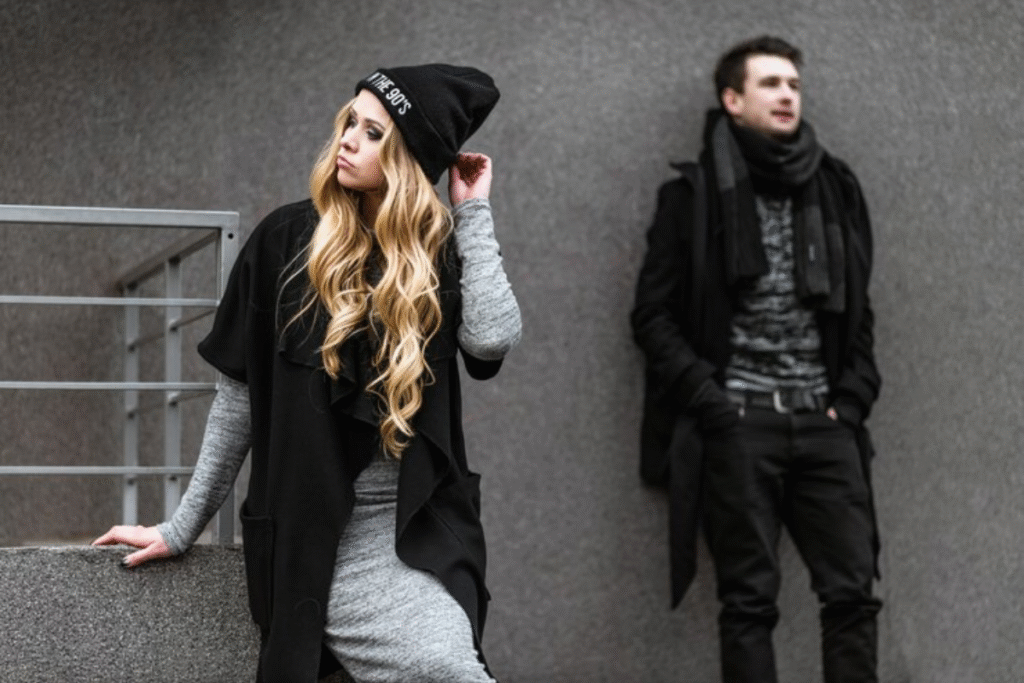Overview : What Is Androgynous Fashion?
Androgynous fashion is more than a trend—it’s a movement that challenges traditional gender norms by blending masculine and feminine elements into one cohesive style. Rooted in self-expression and inclusivity, this fashion philosophy defies the binary lens of clothing, offering a new realm of creativity, freedom, and identity.
In recent years, androgynous fashion has gained immense popularity among celebrities, designers, and consumers alike. From oversized blazers to sleek loafers, the unisex wardrobe is becoming a staple in both streetwear and haute couture.
Why Androgynous Fashion Matters in 2025
As society evolves toward greater acceptance of fluid identities, the fashion industry reflects this shift. The rise of non-binary and genderqueer visibility has paved the way for androgynous styles to flourish. Here’s why it matters:
Gender Expression & Identity
Clothing is a form of expression. Androgynous fashion allows people to feel authentic in their style without being confined to male or female categories.
Sustainability & Minimalism
A gender-neutral wardrobe is inherently more versatile. Instead of needing separate wardrobes for different identities, individuals can invest in quality staples that transcend gender lines.
Cultural Influence
From David Bowie to Janelle Monáe, androgynous icons have long influenced pop culture. Today, that influence is mainstream—on red carpets, fashion runways, and social media platforms.
History of Androgynous Fashion
To understand the current moment, it’s helpful to explore the evolution of androgynous clothing.
Early Influences
- 1920s: Coco Chanel redefined women’s wear with suits and trousers.
- 1970s-1980s: Glam rock artists like Bowie and Prince blurred the lines between masculine and feminine aesthetics.
- 1990s: Minimalist designers like Helmut Lang and Calvin Klein introduced unisex silhouettes.
2000s to Present
- The 2010s saw the rise of gender-fluid celebrities and influencers who used fashion to express identity.
- The 2020s mark a global movement toward inclusive clothing lines and pronoun-neutral branding.
Key Elements of Androgynous Style
The beauty of androgynous fashion lies in its flexibility. Here are the foundational pieces and styling tips that define the look:
1. Neutral Color Palettes
- Blacks, whites, greys, beiges, and earthy tones are common.
- These shades create a clean canvas that emphasizes shape and layering over gender coding.
2. Tailored Pieces
- Blazers, trousers, and suits are essential.
- Look for sharp lines without being overly structured or body-hugging.
3. Loose Fits & Oversized Clothing
- Boxy tops, baggy jeans, and oversized coats help remove gendered cues.
- Comfort meets high style in silhouettes that flow freely.
4. Layering
- Mix blazers with hoodies, or button-ups under vests.
- Layering adds complexity without defining masculinity or femininity.
5. Footwear
- Combat boots, loafers, and sneakers are go-to options.
- Heels and dress shoes can be used sparingly and styled neutrally.
6. Minimalist Accessories
- Avoid overly “feminine” or “masculine” accessories.
- Choose items like leather belts, watches, caps, and minimalist bags.
Androgynous Fashion Brands to Know
The growing demand for gender-neutral apparel has led to the rise of brands focused specifically on androgynous fashion.
1. TomboyX
Originally launched as a queer-friendly underwear brand, TomboyX has expanded into a full line of gender-neutral clothing.
2. Wildfang
With the tagline “Rebel. Tomboy. Feminist,” Wildfang challenges the status quo with bold, gender-free designs.
3. OneDNA
This New York-based brand offers unisex styles that blend streetwear with tailored staples.
4. Rad Hourani
A pioneer in genderless fashion, Rad Hourani’s high-end collections challenge traditional gender aesthetics.
5. Phluid Project
Part retail shop, part activism space, The Phluid Project champions trans, queer, and non-binary designers.
How to Build an Androgynous Wardrobe
Ready to embrace the genderless look? Here’s how to build your wardrobe step-by-step:
Step 1: Declutter Your Closet
Start by removing overly gendered items that don’t align with your personal identity or aesthetic.
Step 2: Invest in Staples
Begin with foundational pieces—white button-downs, black trousers, plain tees, and denim jackets.
Step 3: Experiment with Fit
Play with oversized, relaxed, and structured fits until you find what feels empowering.
Step 4: Mix and Match
Androgynous fashion encourages creativity. Try mixing high-end with thrifted, or masculine jackets with feminine prints.
Step 5: Stay Authentic
Your style should reflect you—not just trends. Androgyny is about blurring lines, not losing your sense of self.
How Celebrities Influence Androgynous Fashion
Celebrities have been instrumental in normalizing androgynous style.
Notable Figures:
- Janelle Monáe: Known for tuxedo-inspired outfits and bold nonbinary expression.
- Harry Styles: Popularized skirts, pearl necklaces, and floral prints for men.
- Zendaya: Frequently sports gender-neutral red carpet ensembles.
- Billy Porter: Pushes fashion boundaries with gowns, capes, and gender-fluid couture.
Social Media and the Rise of Genderless Style
TikTok and Instagram
Platforms like TikTok and Instagram have made androgynous fashion more accessible. Hashtags like #AndrogynousStyle, #GenderNeutral, and #FashionWithoutGender feature millions of posts.
Influencer Culture
Non-binary influencers are reshaping style standards and partnering with major fashion houses for inclusive campaigns.
The Role of Fashion Designers
Top designers and fashion houses are rethinking traditional gender norms.
Runway Movements:
- Gucci: Alessandro Michele’s vision emphasizes unisex glamor.
- Rick Owens: Merges masculinity with avant-garde drapery.
- Harris Reed: A nonbinary designer blending Victorian femininity with masculine tailoring.
Challenges Facing Androgynous Fashion
Despite its growth, the movement faces obstacles:
Retail Infrastructure
Most stores still segregate clothing by gender, making it difficult for nonbinary shoppers.
Sizing Issues
Many androgynous lines struggle with inclusive sizing that fits all body types comfortably.
Cultural Resistance
In some cultures or regions, gendered norms are deeply entrenched, making acceptance slower.
Future of Androgynous Fashion
The future is fluid. As demand for inclusive fashion grows, brands that embrace diversity in identity, size, and style will thrive.
Predictions for 2025 and Beyond:
- Tech-enhanced clothing that adapts to body shape and temperature, removing gendered constraints.
- Virtual fashion shows showcasing genderless AI models.
- Mainstream acceptance of gender-neutral clothing in workwear and school uniforms.
SEO Best Practices Summary
To ensure this content ranks #1 on Google:
- Keyword Density: “Androgynous fashion” appears naturally throughout.
- Meta Tags & Structure: Proper H2/H3 usage and keyword-rich headings.
- User Experience: Informative, well-organized, and readable format.
- Answering Search Intent: Covers what is it, how to wear it, where to shop, and more.
FAQs About Androgynous Fashion
What does androgynous fashion mean?
It refers to a style that incorporates elements of both masculine and feminine fashion, often blending or eliminating gender distinctions altogether.
Can anyone wear androgynous fashion?
Absolutely! It’s inclusive and open to all identities, body types, and personal styles.
Is androgynous fashion the same as unisex?
Not exactly. Unisex is more about universal fit, while androgynous fashion is a deliberate blending of masculine and feminine aesthetics.
Where can I buy androgynous clothes?
Look for brands like Wildfang, TomboyX, Phluid Project, and check out gender-neutral sections in mainstream retailers like ASOS and Zara.
How do I start dressing androgynously?
Start with neutral tones, minimalist designs, and clothing that feels comfortable yet stylish without leaning heavily into masculine or feminine stereotypes.
Final Thoughts
Androgynous fashion is more than just a style—it’s a cultural shift. As more people reject binary thinking, fashion becomes a powerful tool of expression and empowerment. Whether you’re looking to challenge societal norms or simply dress authentically, androgynous fashion offers the freedom to be you—without limits.



